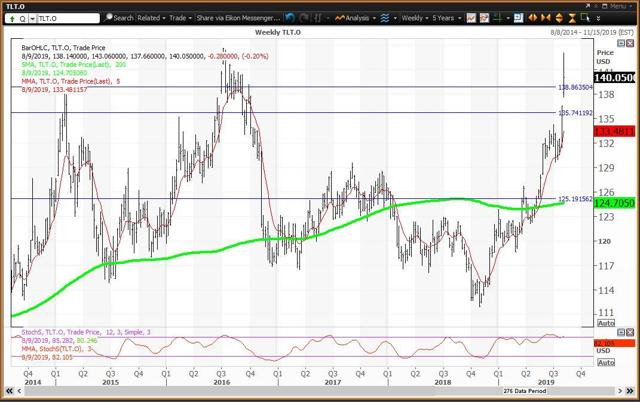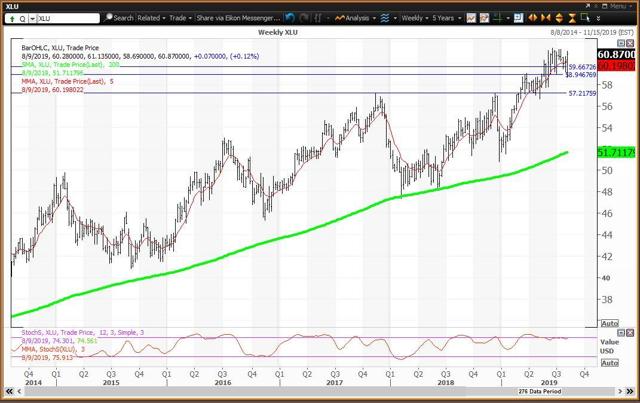[ad_1]
The yield on the 30-year Treasury bond yield fell to as low as 2.123% last week, approaching its all-time low of 2.089% set during the week of July 15, 2016. The cycle low yield is 2.089% set in July 2016. My quarterly value level is 2.873% with semiannual and monthly pivots at 2.431% and 2.256%, respectively, with my annual risky level at 1.756%.
The dividend yield for the utilities stock ETF is 3.19%.
I continue to recommend that investors avoid junk bonds.
Here are weekly charts for these ETFs
The iShares 20+ Year Treasury Bond ETF (NYSEARCA:TLT)
The U.S. Treasury 30-year bond ETF trades like a stock and is a basket of U.S. Treasury bonds with maturities of 20+ years to 30 years. As a stock-type investment, it never matures and interest income is converted to periodic dividend payments.
 Courtesy of Refinitiv XENITH
Courtesy of Refinitiv XENITH
The Treasury bond ETF ($140.05 on Aug. 9) is up 15.3% year to date and set its 2019 high of $143.06 on Aug. 7. This ETF is in bull market territory, up 25.2% from its 2018 low of $111.90 set on Nov. 2. TLT has a positive but overbought weekly chart with the ETF above its five-week modified moving average of $133.48 and well above its 200-week simple moving average or “reversion to the mean” at $124.71. The 12x3x3 weekly slow stochastic reading rose to 82.11 last week, up from 80.52 on Aug. 2, moving above the overbought threshold of 80.00.
Investor Strategy: Buy weakness to its semiannual pivot at $135.75 and reduce holdings on strength to its annual risky level at $145.84. Its monthly pivot is $138.89.
The Utilities Select Sector SPDR ETF (NYSEARCA:XLU)
 Courtesy of Refinitiv XENITH
Courtesy of Refinitiv XENITH
The utility stock ETF ($60.87 on Aug. 9) is up 15% so far in 2019 and is 19.8% above its Dec. 26 low of $50.81. XLU has a neutral weekly chart with the ETF above its 5-week modified moving average at $60.20 and well above its 200-week simple moving average or “reversion to the mean” at $51.71. The 12x3x3 weekly slow stochastic reading slipped to 75.91 last week, down from 76.72 on Aug. 2.
Investor Strategy: Investors should buy weakness to its quarterly value level of $57.20 and its 200-week simple moving average at $51.71. Reduce holdings on strength to the semiannual risky level at $63.67. Annual and monthly pivots are $58.98 and $59.64, respectively.
SPDR Bloomberg Barclays High Yield Bond ETF (NYSEARCA:JNK)
 Courtesy of Refinitiv XENITH
Courtesy of Refinitiv XENITH
The junk bond ETF ($107.60 on Aug. 9) is up 6.8% so far in 2019 and is 9% above its Dec. 26 low of $98.76. The weekly chart for JNK is negative with the ETF below its five-week modified moving average at $108.11. The ETF is just below its 200-week simple moving average or “reversion to the mean” at $107.61. The 12x3x3 weekly slow stochastic reading slipped to 68.12 last week, down from 70.48 on Aug. 2.
Investor Strategy: Buy weakness to its annual and semiannual value levels at $102.60 and $99.15, respectively. Reduce holdings on strength to its monthly risky level at $109.78. Its quarterly pivot is $104.14.
How to use my value levels and risky levels:
Value levels and risky levels are based upon the last nine weekly, monthly, quarterly, semiannual and annual closes. The first set of levels was based upon the closes on Dec. 31. The original annual level remains in play. The weekly level changes each week. The monthly level was changed at the end of each month, the latest on July 31. The quarterly level was changed at the end of June. My theory is that nine years of volatility between closes are enough to assume that all possible bullish or bearish events for the stock are factored in. To capture share price volatility, investors should buy on weakness to a value level and reduce holdings on strength to a risky level. A pivot is a value level or risky level that was violated within its time horizon. Pivots act as magnets that have a high probability of being tested again before its time horizon expires.
Disclosure: I/we have no positions in any stocks mentioned, and no plans to initiate any positions within the next 72 hours. I wrote this article myself, and it expresses my own opinions. I am not receiving compensation for it (other than from Seeking Alpha). I have no business relationship with any company whose stock is mentioned in this article.
[ad_2]
Source link Google News

